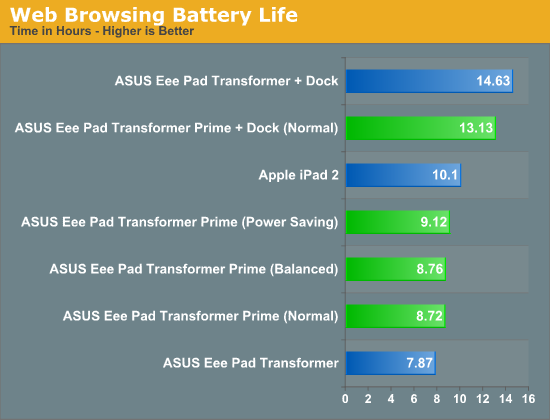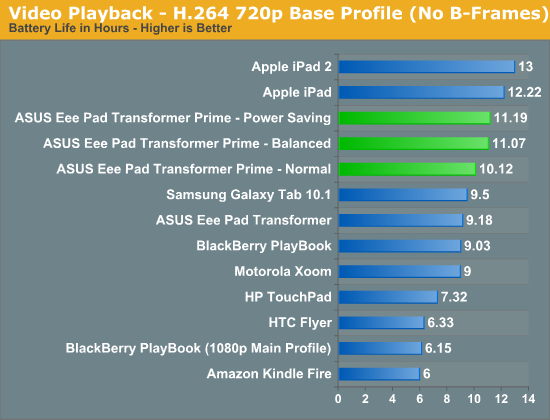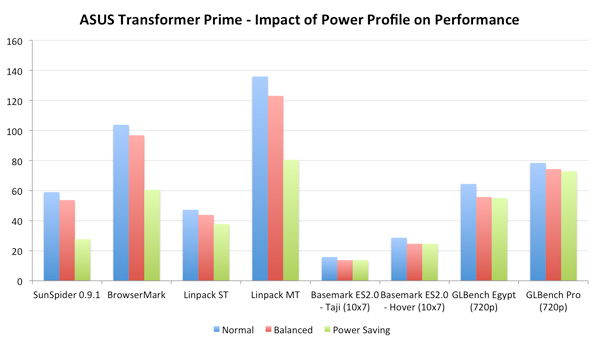ASUS Eee Pad Transformer Prime Review Part II: Battery Life & More
by Anand Lal Shimpi on December 15, 2011 3:45 AM ESTThe Final Word on Battery Life
In our iPhone 4S review I mentioned that our web browsing battery life tests were in dire need of an update. The move to iOS 5 increased the aggressiveness of browser side caching, which impacted our old tests significantly. We still have plans for a much more significant departure from our existing battery life testing methodology, however as an interim solution I developed a modified version of our traditional smartphone battery life test.
The old web browsing test lacked any significant cache busting features and the HTML workload itself was more representative of mobile sites than a full desktop experience. The modified test does a much better job of not allowing its components to be cached by the browser, and includes both lighter and full desktop websites. Since the workload has changed, these numbers are no longer comparable to those running the older version of our test. The new web browsing test is also stressful enough to span both smartphones and tablets, whereas before we had a separate version just for tablets.
Finally, I must mention that we ensure all tablets tested here are normalized to the same display brightness setting of 200 nits for a true apples to apples comparison. As always we rely on the stock web browser that ships with the platform and manually quit all background tasks before running our tests. In the case of the Transformer Prime, I was able to run our new battery life test using all three power profiles to get a better idea of the range of battery life. As a recap, here are the details on the power profiles.
ASUS and NVIDIA have defined three power profiles on the Prime: Normal, Balanced, and Power Saving. Normal allows the CPU to run at up to 1.4GHz with only a single core active, and 1.3GHz otherwise. Balanced is the default setting and it drops maximum CPU clock to 1.2GHz and favors lower clock/voltage targets on the curve compared to Normal mode. Power Saving caps CPU frequency at 1GHz with 1—2 cores active, 760MHz with 3 cores active and 620MHz with 4 cores active. It's unclear what the impact is on GPU clocks/performance. I've also noticed that the Power Saving profile also enables a dynamic contrast control that you can't override.

The shipping Prime does much better than the original tablet I reviewed a couple of weeks ago. It's clear that whatever was impacting WiFi performance also took its toll on battery life. What I suspected might be the case ended up being true: the implementation of Tegra 3 in the Transformer Prime delivers better battery life than Tegra 2 in the original Eee Pad Transformer. There are too many variables here for me to attribute the gains to NVIDIA's SoC alone, but seeing as how battery capacity hasn't changed it's likely that we do have Tegra 3 to thank for better battery life in the TF Prime.
Note that even running in Normal mode and allowing all four cores to run at up to 1.3GHz, Tegra 3 is able to post better battery life than Tegra 2. I suspect this is because NVIDIA is able to parallelize some of the web page loading process across all four cores, delivering similar performance to the original Transformer but at lower frequency/voltage settings across all of the cores. Additional performance gained by supporting NEON likely helps improve efficiency, not to mention higher single-threaded performance thanks to Tegra 3's higher clocks. Combine all of this with a more mature 40nm process and a more mature Cortex A9 implementation on that process, and the power improvements make sense.
The Transformer Prime is still unable to dethrone the iPad 2 here, which just goes to show you how efficient Apple's platform was to begin with. That being said, the Prime is within striking distance of Apple's tablet. The race is now close enough where you won't notice too much of a difference between the two.
There's also not a huge difference in battery life between the various power profiles. I do applaud ASUS and NVIDIA for giving us control over the CPU governor, but unless you're trying to make the tablet last over a very long flight you're probably fine just leaving it in Normal mode and enjoying the extra performance.
I included results from the Prime running with its dock attached. The additional 22Wh battery improved battery life by 51%. The scaling isn't linear because the dock itself draws power. Once the dock's battery is depleted, the tablet needs to power both itself and the dock. The improvement is tangible though, if you need to do a lot of writing on a flight around the world the dock will help you get there.
Video playback battery life is much better than the original Eee Pad Transformer. Tegra 2 was clearly broken when it came to its video decode abilities and as a result we saw significant limitations on both what video you could play and how long you could play them. Tegra 3 fixes all of that, and the result is battery life that's getting closer to the iPad 2:

Getting 11 hours of continuous video playback battery life is something to be proud of. Being able to watch 4-6 full length movies on a plane without worrying about your battery is a pretty nice feature. Unlike the active use case, video playback seems to see a bigger benefit from switching away from the Normal power profile.











58 Comments
View All Comments
metafor - Thursday, December 15, 2011 - link
Yes. Since Tegra 3 is actually capable of clock-gating individual cores as opposed to all-or-nothing like Tegra 2, power utilization should be better.That in combination with display local dimming and lower voltage -- since the CPU's are made on 40G -- definitely help brings per-core power down.
The question is whether or not the performance is there to compete with SoC's on Android early next year with Samsung's new Exynos and Krait based devices.
TareX - Thursday, December 15, 2011 - link
Quite off topic, but I expected Anand's Galaxy Nexus review to be out by US launch day...Death666Angel - Thursday, December 15, 2011 - link
Is it now the norm to compare products based on their size rather than ability and, most importantly, price? A Netbook probably retails for $250-$400. This thing retails for $650 (with dock)? I don't see how this in any way compares to a netbook. Sorry.quiksilvr - Thursday, December 15, 2011 - link
It isn't fair comparing the two because the ASUS has a 10.1" screen at 1280x800, not a 9.7" screen at 1024x768. Thats a 0.78MP screen vs a 1.0MP screen. It has to render 20% more pixels and on top of that the screen is larger.quiksilvr - Thursday, December 15, 2011 - link
I'm referring to battery life.Confusador - Thursday, December 15, 2011 - link
Thanks for doing the follow up on this, demonstrating once again why you're the best in the business.Hopefully Asus will learn from this; if you weren't as thorough as you are they would have ended up with their only review here being unnecessarily negative. Maybe they'll give folks more lead time in the future!
fteoath64 - Friday, December 16, 2011 - link
So there is just some improvement and not a great deal of improvement. Wonder if it would be better if Nvidia put two 1.8Ghz cores rather than 4 1.4Ghz core, then the end result in performance would be way better with slight penalty on battery life ?.I guess I have to wait for the A15 cores then!.
Mugur - Friday, December 16, 2011 - link
Asus should've done the impossible and have it ready by Christmas with ICS on it and aggresively priced. It would've been an instant hit.vcarvega - Friday, December 16, 2011 - link
I do think it is commendable of you to update your original review with these updated tidbits. However, I do wonder when it comes to your gripes, particularly with multitasking.I agree with the limitations of Honeycomb's multitasking, but what are we comparing it too? Your review was specifically comparing it to a netbook, so your criticism is fair if we're comparing it to Win XP... but compared to other mobile OS', it's the best on offer (admittedly, I have not tried the Playbook's implementation of multitasking which looks like it may be more comparable to a desktop experience).
Currently, I think heavy users run into serious limitation regardless of which tablet platform they are using. I think I was hoping for quad core to change this as well tho... so that's disappointing. Maybe ICS?
Your comments on higher clocked, dual-core 28nm chips possibly being comparable in performance to Tegra 3 gave me reason to pause as well! Simply b/c I fear that Android 4.0 is still being optimized for dual core devices, not quad core... Because unless things change at CES, most new mobile devices being announced for 2012 still have dual cores!
vision33r - Friday, December 16, 2011 - link
Really bad timing. There are so many phones out right now that makes the Razr look outdated.For starters, this phone doesn't even beat the SSGS2 which came out more than 6 months ago.
Now we have GalaxyNexus Prime, HTC Rezound. Upcoming phones will all have LTE, 720p displays, and better performance.